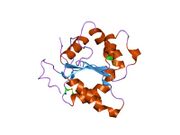Biology:TLR 1
 Generic protein structure example |
TLR 1 is a member of the toll-like receptor family (TLR) of pattern recognition receptors of the innate immune system.[1][2] TLR1 recognizes pathogen-associated molecular pattern with a specificity for gram-positive bacteria. TLR1 has also been designated as CD281 (cluster of differentiation 281).
TLRs are highly conserved from Drosophila to humans and share structural and functional similarities. They recognize pathogen-associated molecular patterns (PAMPs) that are expressed on infectious agents, and mediate the production of cytokines necessary for the development of effective immunity. The various TLRs exhibit different patterns of expression. This gene is ubiquitously expressed, and at higher levels than other TLR genes. Different length transcripts presumably resulting from use of alternative polyadenylation site, and/or from alternative splicing, have been noted for this gene.[3]
TLR1 recognizes peptidoglycan and (triacyl) lipopeptides in concert with TLR2 (as a heterodimer).[4][5] Toll-like receptors, including TLR-1, found on the epithelial cell layer that lines the small and large intestine are important players in the management of the gut microbiota and detection of pathogens.[6] It is also found on the surface of macrophages and neutrophils.
Interactions
TLR 1 has been shown to interact with TLR 2.[7]
References
- ↑ "A family of human receptors structurally related to Drosophila Toll". Proc. Natl. Acad. Sci. U.S.A. 95 (2): 588–93. January 1998. doi:10.1073/pnas.95.2.588. PMID 9435236. Bibcode: 1998PNAS...95..588R.
- ↑ "Toll-like receptors". Crit. Care Med. 30 (1 Suppl): S1–11. January 2002. doi:10.1097/00003246-200201001-00001. PMID 11782555. http://www.ccmjournal.com/pt/re/ccm/abstract.00003246-200201001-00001.htm.
- ↑ "SRF serum response factor". Entrez Gene. National Center for Biotechnology Information, National Institutes of Health. https://www.ncbi.nlm.nih.gov/sites/entrez?Db=gene&Cmd=ShowDetailView&TermToSearch=7096.
- ↑ "Heterodimerization of TLR2 with TLR1 or TLR6 expands the ligand spectrum but does not lead to differential signaling". J. Leukoc. Biol. 83 (3): 692–701. March 2008. doi:10.1189/jlb.0807586. PMID 18056480.
- ↑ "Crystal structure of the TLR1-TLR2 heterodimer induced by binding of a tri-acylated lipopeptide". Cell 130 (6): 1071–82. September 2007. doi:10.1016/j.cell.2007.09.008. PMID 17889651.
- ↑ "Regulation of Intestinal Immune Responses through TLR Activation: Implications for Pro- and Prebiotics". Frontiers in Immunology 5: 60. 2014. doi:10.3389/fimmu.2014.00060. PMID 24600450.
- ↑ "Cutting edge: role of Toll-like receptor 1 in mediating immune response to microbial lipoproteins". J. Immunol. 169 (1): 10–4. Jul 2002. doi:10.4049/jimmunol.169.1.10. PMID 12077222.
External links
- Toll-Like+Receptor+1 at the US National Library of Medicine Medical Subject Headings (MeSH)
- PDBe-KB provides an overview of all the structure information available in the PDB for Human Toll-like receptor 1 (TLR1)
This article incorporates text from the United States National Library of Medicine ([1]), which is in the public domain.


